Critical Analysis of RCT Study
VerifiedAdded on 2023/01/10
|15
|4251
|40
AI Summary
This critical analysis examines a randomized clinical trial study on the efficacy of a targeted infection prevention intervention in nursing home residents with indwelling devices. The analysis evaluates the study design, randomization process, blinding, sample size, outcomes, and applicability of the results.
Contribute Materials
Your contribution can guide someone’s learning journey. Share your
documents today.
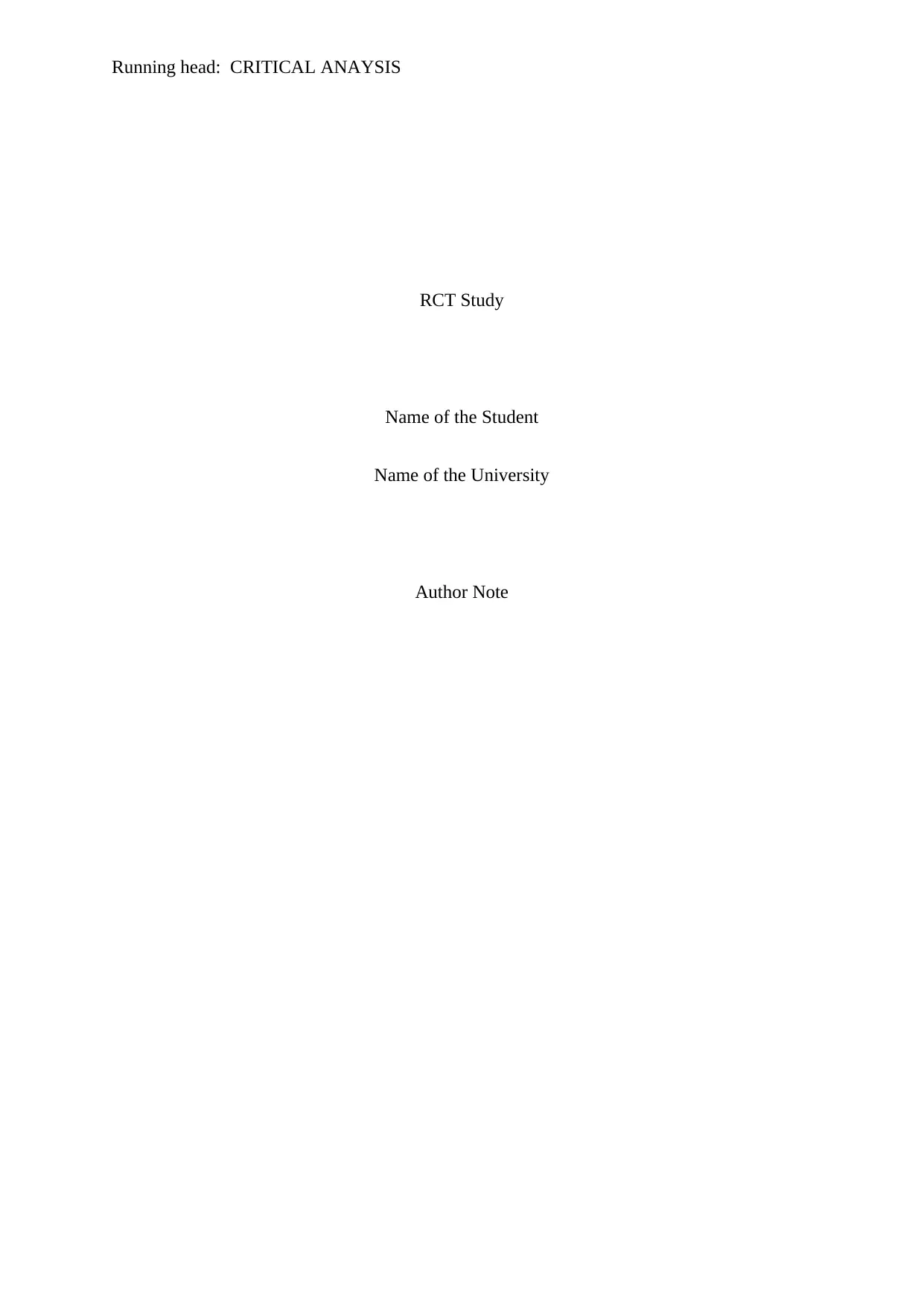
Running head: CRITICAL ANAYSIS
RCT Study
Name of the Student
Name of the University
Author Note
RCT Study
Name of the Student
Name of the University
Author Note
Secure Best Marks with AI Grader
Need help grading? Try our AI Grader for instant feedback on your assignments.

1
CRITICAL ANAYSIS
Paper to be analyzed
Mody, L., Krein, S. L., Saint, S., Min, L. C., Montoya, A., Lansing, B., ... & Rye, R. A.
(2015). A targeted infection prevention intervention in nursing home residents with
indwelling devices: a randomized clinical trial. JAMA internal medicine, 175(5), 714-723.
Answer 1
Yes.
The trail addressed clearly focused issue. The objective of the study is to analyse
efficacy of multimodal infection program (TIP) in reducing the prevalence of multidrug-
resistant organisms (MDROs) and device-related infections. Thus the intervention includes
TIP and the outcome is decreased prevalence of infection. The main target population was
NHS patients in 12 different community based units covering 137 beds. The enrolment
period of the study is 36 months. The study also used control cohort (Mody et al., 2015).
Malmivaara (2016) stated that in order to design a proper randomized control trial (RCTs), a
proper PICO question must be designed covering the population to be studied, interventions
to be used, comparator used and the outcome of the study. Framing RCT with PICO helps to
strengthened the research framework.
Answer 2
The study selected to randomise NHS instead of the participants by the use of cluster
randomization. Hemming, Eldridge, Forbes, Weijer and Taljaard (2017) reported that cluster
randomisation trials provide increased return as the power along with precision size of the
cluster increases. The designed efficient trials and the number of cultures along with cluster
size concurrently and non-independently and thereby helping to improve the stratification of
CRITICAL ANAYSIS
Paper to be analyzed
Mody, L., Krein, S. L., Saint, S., Min, L. C., Montoya, A., Lansing, B., ... & Rye, R. A.
(2015). A targeted infection prevention intervention in nursing home residents with
indwelling devices: a randomized clinical trial. JAMA internal medicine, 175(5), 714-723.
Answer 1
Yes.
The trail addressed clearly focused issue. The objective of the study is to analyse
efficacy of multimodal infection program (TIP) in reducing the prevalence of multidrug-
resistant organisms (MDROs) and device-related infections. Thus the intervention includes
TIP and the outcome is decreased prevalence of infection. The main target population was
NHS patients in 12 different community based units covering 137 beds. The enrolment
period of the study is 36 months. The study also used control cohort (Mody et al., 2015).
Malmivaara (2016) stated that in order to design a proper randomized control trial (RCTs), a
proper PICO question must be designed covering the population to be studied, interventions
to be used, comparator used and the outcome of the study. Framing RCT with PICO helps to
strengthened the research framework.
Answer 2
The study selected to randomise NHS instead of the participants by the use of cluster
randomization. Hemming, Eldridge, Forbes, Weijer and Taljaard (2017) reported that cluster
randomisation trials provide increased return as the power along with precision size of the
cluster increases. The designed efficient trials and the number of cultures along with cluster
size concurrently and non-independently and thereby helping to improve the stratification of
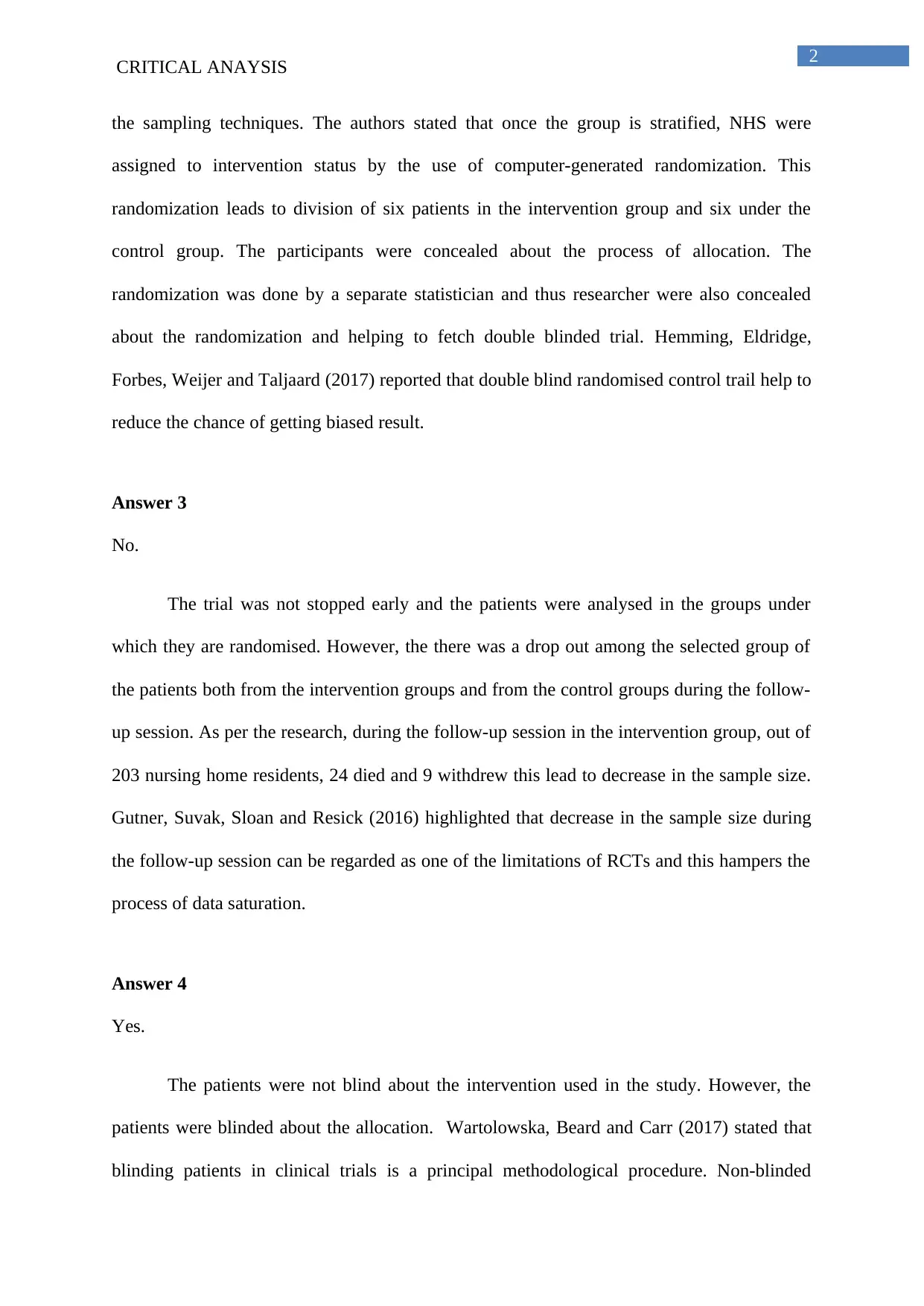
2
CRITICAL ANAYSIS
the sampling techniques. The authors stated that once the group is stratified, NHS were
assigned to intervention status by the use of computer-generated randomization. This
randomization leads to division of six patients in the intervention group and six under the
control group. The participants were concealed about the process of allocation. The
randomization was done by a separate statistician and thus researcher were also concealed
about the randomization and helping to fetch double blinded trial. Hemming, Eldridge,
Forbes, Weijer and Taljaard (2017) reported that double blind randomised control trail help to
reduce the chance of getting biased result.
Answer 3
No.
The trial was not stopped early and the patients were analysed in the groups under
which they are randomised. However, the there was a drop out among the selected group of
the patients both from the intervention groups and from the control groups during the follow-
up session. As per the research, during the follow-up session in the intervention group, out of
203 nursing home residents, 24 died and 9 withdrew this lead to decrease in the sample size.
Gutner, Suvak, Sloan and Resick (2016) highlighted that decrease in the sample size during
the follow-up session can be regarded as one of the limitations of RCTs and this hampers the
process of data saturation.
Answer 4
Yes.
The patients were not blind about the intervention used in the study. However, the
patients were blinded about the allocation. Wartolowska, Beard and Carr (2017) stated that
blinding patients in clinical trials is a principal methodological procedure. Non-blinded
CRITICAL ANAYSIS
the sampling techniques. The authors stated that once the group is stratified, NHS were
assigned to intervention status by the use of computer-generated randomization. This
randomization leads to division of six patients in the intervention group and six under the
control group. The participants were concealed about the process of allocation. The
randomization was done by a separate statistician and thus researcher were also concealed
about the randomization and helping to fetch double blinded trial. Hemming, Eldridge,
Forbes, Weijer and Taljaard (2017) reported that double blind randomised control trail help to
reduce the chance of getting biased result.
Answer 3
No.
The trial was not stopped early and the patients were analysed in the groups under
which they are randomised. However, the there was a drop out among the selected group of
the patients both from the intervention groups and from the control groups during the follow-
up session. As per the research, during the follow-up session in the intervention group, out of
203 nursing home residents, 24 died and 9 withdrew this lead to decrease in the sample size.
Gutner, Suvak, Sloan and Resick (2016) highlighted that decrease in the sample size during
the follow-up session can be regarded as one of the limitations of RCTs and this hampers the
process of data saturation.
Answer 4
Yes.
The patients were not blind about the intervention used in the study. However, the
patients were blinded about the allocation. Wartolowska, Beard and Carr (2017) stated that
blinding patients in clinical trials is a principal methodological procedure. Non-blinded
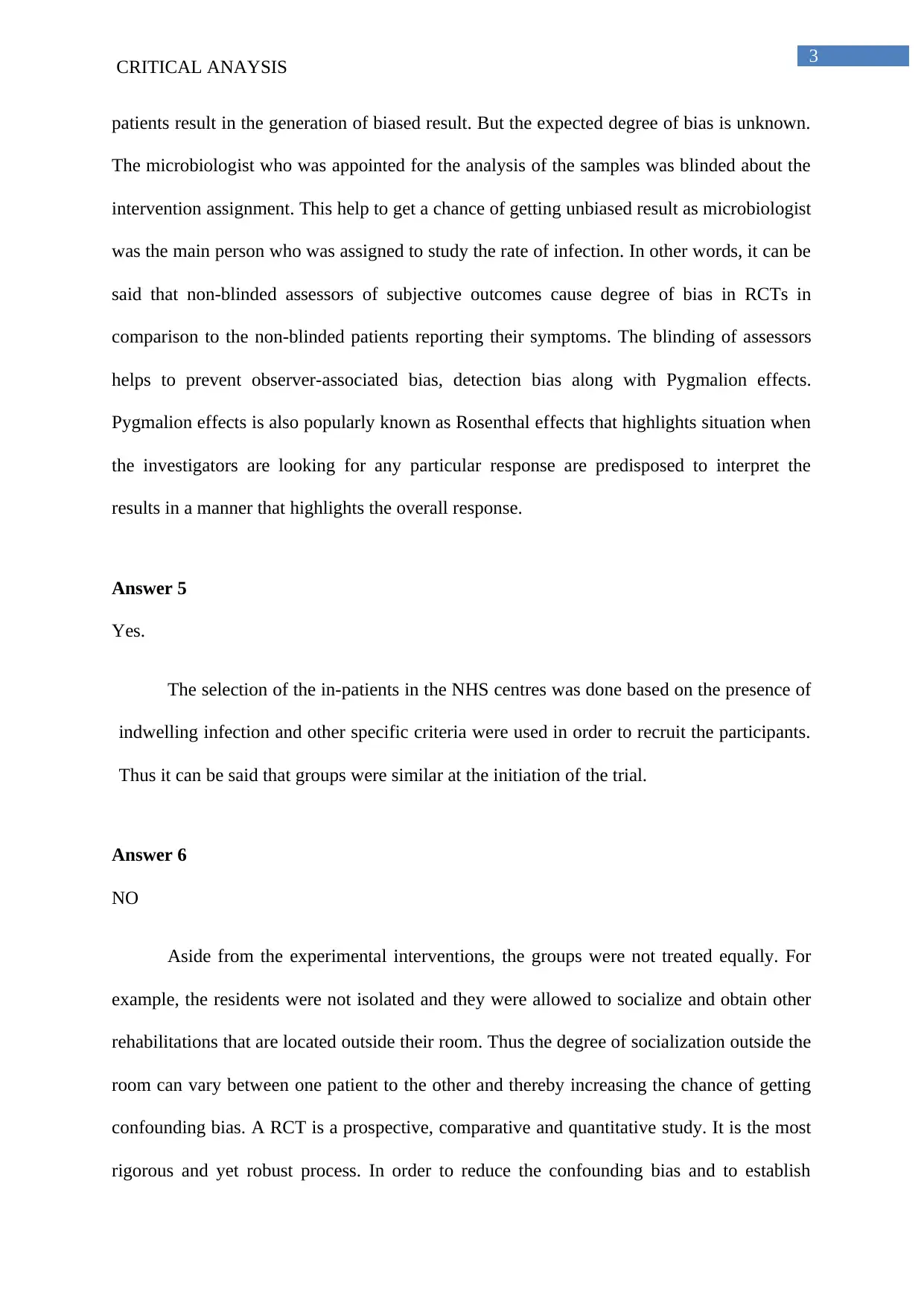
3
CRITICAL ANAYSIS
patients result in the generation of biased result. But the expected degree of bias is unknown.
The microbiologist who was appointed for the analysis of the samples was blinded about the
intervention assignment. This help to get a chance of getting unbiased result as microbiologist
was the main person who was assigned to study the rate of infection. In other words, it can be
said that non-blinded assessors of subjective outcomes cause degree of bias in RCTs in
comparison to the non-blinded patients reporting their symptoms. The blinding of assessors
helps to prevent observer-associated bias, detection bias along with Pygmalion effects.
Pygmalion effects is also popularly known as Rosenthal effects that highlights situation when
the investigators are looking for any particular response are predisposed to interpret the
results in a manner that highlights the overall response.
Answer 5
Yes.
The selection of the in-patients in the NHS centres was done based on the presence of
indwelling infection and other specific criteria were used in order to recruit the participants.
Thus it can be said that groups were similar at the initiation of the trial.
Answer 6
NO
Aside from the experimental interventions, the groups were not treated equally. For
example, the residents were not isolated and they were allowed to socialize and obtain other
rehabilitations that are located outside their room. Thus the degree of socialization outside the
room can vary between one patient to the other and thereby increasing the chance of getting
confounding bias. A RCT is a prospective, comparative and quantitative study. It is the most
rigorous and yet robust process. In order to reduce the confounding bias and to establish
CRITICAL ANAYSIS
patients result in the generation of biased result. But the expected degree of bias is unknown.
The microbiologist who was appointed for the analysis of the samples was blinded about the
intervention assignment. This help to get a chance of getting unbiased result as microbiologist
was the main person who was assigned to study the rate of infection. In other words, it can be
said that non-blinded assessors of subjective outcomes cause degree of bias in RCTs in
comparison to the non-blinded patients reporting their symptoms. The blinding of assessors
helps to prevent observer-associated bias, detection bias along with Pygmalion effects.
Pygmalion effects is also popularly known as Rosenthal effects that highlights situation when
the investigators are looking for any particular response are predisposed to interpret the
results in a manner that highlights the overall response.
Answer 5
Yes.
The selection of the in-patients in the NHS centres was done based on the presence of
indwelling infection and other specific criteria were used in order to recruit the participants.
Thus it can be said that groups were similar at the initiation of the trial.
Answer 6
NO
Aside from the experimental interventions, the groups were not treated equally. For
example, the residents were not isolated and they were allowed to socialize and obtain other
rehabilitations that are located outside their room. Thus the degree of socialization outside the
room can vary between one patient to the other and thereby increasing the chance of getting
confounding bias. A RCT is a prospective, comparative and quantitative study. It is the most
rigorous and yet robust process. In order to reduce the confounding bias and to establish
Secure Best Marks with AI Grader
Need help grading? Try our AI Grader for instant feedback on your assignments.

4
CRITICAL ANAYSIS
proper cause and effect relationship, the study must treat both the experimental and control
group equally apart from the intervention (Bhide, Shah & Acharya, 2018).
Answer 7
The primary outcome of the study was to measure the overall MDRO prevalence
density rate that is defined as total number of each participants' of MDRO-positive anatomic
sites through all MDROs per visit averaged over the tenure of their participation. The
secondary outcome include effect of the intervention given on an individuals' risk factors
over the new MDRO acquisition that is defined as number of residents with new acquisition
per 1000 device that are at risk as exploratory analyses. Other secondary outcome include
incidence of device-associated infections per 1000 device-days and is defined by the presence
of clinical medical record documentation and administration of systemic antibiotic.
Answer 8
The estimation of the treatment effect was precise. In order to highlight significant
outcome by comparing the control and the experimental group, the 95% of CI (confidence
interval) was selected). McCormack, Vandermeer and Allan (2013) stated that a well-
designed RCT is least biased way for evaluating the difference between different therapeutic
interventions. The point of estimate of an RCT study is CI. a CI presented with 95% (or up to
99%) helps to ascertain significant outcome. The selection of the CI comes from the
convention of p-value of 0.05 that represents statistical significance. Higher is the CI, more is
the significance of the evaluated results and chance of replication of the same data in other
population.
Answer 9
Yes.
CRITICAL ANAYSIS
proper cause and effect relationship, the study must treat both the experimental and control
group equally apart from the intervention (Bhide, Shah & Acharya, 2018).
Answer 7
The primary outcome of the study was to measure the overall MDRO prevalence
density rate that is defined as total number of each participants' of MDRO-positive anatomic
sites through all MDROs per visit averaged over the tenure of their participation. The
secondary outcome include effect of the intervention given on an individuals' risk factors
over the new MDRO acquisition that is defined as number of residents with new acquisition
per 1000 device that are at risk as exploratory analyses. Other secondary outcome include
incidence of device-associated infections per 1000 device-days and is defined by the presence
of clinical medical record documentation and administration of systemic antibiotic.
Answer 8
The estimation of the treatment effect was precise. In order to highlight significant
outcome by comparing the control and the experimental group, the 95% of CI (confidence
interval) was selected). McCormack, Vandermeer and Allan (2013) stated that a well-
designed RCT is least biased way for evaluating the difference between different therapeutic
interventions. The point of estimate of an RCT study is CI. a CI presented with 95% (or up to
99%) helps to ascertain significant outcome. The selection of the CI comes from the
convention of p-value of 0.05 that represents statistical significance. Higher is the CI, more is
the significance of the evaluated results and chance of replication of the same data in other
population.
Answer 9
Yes.

5
CRITICAL ANAYSIS
The results can be applied to the local population. This is because, the patients who
are covered in the trial are identical enough to the group of population generally found under
the hospital settings. The authors mainly selected patients from NHs units at the community
level in order to study the level of infection control. Geisinger and Isberg (2017) reported that
disease caused by the multi-drug resistant bacteria under the hospital settings are mainly an
outcome of complex relationship with numerous dynamic factor like the pathogenicity of the
bacteria, resistance in human host, lack of proper infection control measures ad improper
antibiotic therapy. This increase in the MDRO increase hospital related mortality and
morbidity and is also harmful for mankind. Majority of the hospital patient becomes victim of
MDRO through nosocomial infection and thus increasing the cost of care. Thus use of TIP
intervention can be done under diverse hospital settings that are prone to noscomial infection.
Answer 10
Yes.
All the clinical important outcomes that showed significant p-value was considered in
the study. The study showed that the multimodal TIP intervention help in decreasing the
MDRO prevalence density, restriction in the acquisition of new methicillin resistant S.
aureus acquisitions and other clinically-associated urinary tract infection with indwelling
devises. Thus the authors selected all the important route of noscomial infection under the
hospital settings and how TIP help to reduce chances of noscomial infection and helping to
improve the overall significance of the study under the hospital settings. Raja, Ashraf, Raja,
Anjum and Mubarak (2019) stated that multi-drug resistant Staphylococcus aureus (MRSA)
are one of the common cause behind the hospital acquired infection. Thus, finding as
effective path for beating MRSA is effective in reducing the disease burden over indwelling
patients.
CRITICAL ANAYSIS
The results can be applied to the local population. This is because, the patients who
are covered in the trial are identical enough to the group of population generally found under
the hospital settings. The authors mainly selected patients from NHs units at the community
level in order to study the level of infection control. Geisinger and Isberg (2017) reported that
disease caused by the multi-drug resistant bacteria under the hospital settings are mainly an
outcome of complex relationship with numerous dynamic factor like the pathogenicity of the
bacteria, resistance in human host, lack of proper infection control measures ad improper
antibiotic therapy. This increase in the MDRO increase hospital related mortality and
morbidity and is also harmful for mankind. Majority of the hospital patient becomes victim of
MDRO through nosocomial infection and thus increasing the cost of care. Thus use of TIP
intervention can be done under diverse hospital settings that are prone to noscomial infection.
Answer 10
Yes.
All the clinical important outcomes that showed significant p-value was considered in
the study. The study showed that the multimodal TIP intervention help in decreasing the
MDRO prevalence density, restriction in the acquisition of new methicillin resistant S.
aureus acquisitions and other clinically-associated urinary tract infection with indwelling
devises. Thus the authors selected all the important route of noscomial infection under the
hospital settings and how TIP help to reduce chances of noscomial infection and helping to
improve the overall significance of the study under the hospital settings. Raja, Ashraf, Raja,
Anjum and Mubarak (2019) stated that multi-drug resistant Staphylococcus aureus (MRSA)
are one of the common cause behind the hospital acquired infection. Thus, finding as
effective path for beating MRSA is effective in reducing the disease burden over indwelling
patients.

6
CRITICAL ANAYSIS
Answer 11
Yes.
The benefits are worth cost and harm. Cornejo-Juárez, P., Vilar-Compte, Pérez-
Jiménez, Namendys-Silva, Sandoval-Hernández and Volkow-Fernández (2015) stated that
MDRO is increasing the healthcare concern worldwide. One of the important concerns of
MDRO is increase in the provision for hospital acquired infection (HAIs). Patients who are
immune compromised (like the cancer patients) or have been in hospital for a prolong period
of time due to organ transplant of fighting against chronic infect are prone towards getting
affected with HAIs. HAIs are fatal as it increases the cost of care, increased length of stay at
the hospital along with increase mortality and morbidity. The use of the antimicrobial
stewardship program is effective in preventing HAIs under the hospital settings. The
multimodal approach helps in promoting the concept of the antimicrobial stewardship
program and thus it can be said that use of this approach will help to reduce the overall harm
to the patients. Reduction in the chances of HAIs has greater positive consequences and
helping to prevent the spread of MDRO into other population (Cornejo-Juárez, P., Vilar-
Compte, Pérez-Jiménez, Namendys-Silva, Sandoval-Hernández & Volkow-Fernández (2015.
Moreover, the study also does not cover any significant harm to the overall population. So
multimodal approach for its beneficial effects can be selected against all minima; harm as an
intervention for combating HAIs.
CRITICAL ANAYSIS
Answer 11
Yes.
The benefits are worth cost and harm. Cornejo-Juárez, P., Vilar-Compte, Pérez-
Jiménez, Namendys-Silva, Sandoval-Hernández and Volkow-Fernández (2015) stated that
MDRO is increasing the healthcare concern worldwide. One of the important concerns of
MDRO is increase in the provision for hospital acquired infection (HAIs). Patients who are
immune compromised (like the cancer patients) or have been in hospital for a prolong period
of time due to organ transplant of fighting against chronic infect are prone towards getting
affected with HAIs. HAIs are fatal as it increases the cost of care, increased length of stay at
the hospital along with increase mortality and morbidity. The use of the antimicrobial
stewardship program is effective in preventing HAIs under the hospital settings. The
multimodal approach helps in promoting the concept of the antimicrobial stewardship
program and thus it can be said that use of this approach will help to reduce the overall harm
to the patients. Reduction in the chances of HAIs has greater positive consequences and
helping to prevent the spread of MDRO into other population (Cornejo-Juárez, P., Vilar-
Compte, Pérez-Jiménez, Namendys-Silva, Sandoval-Hernández & Volkow-Fernández (2015.
Moreover, the study also does not cover any significant harm to the overall population. So
multimodal approach for its beneficial effects can be selected against all minima; harm as an
intervention for combating HAIs.
Paraphrase This Document
Need a fresh take? Get an instant paraphrase of this document with our AI Paraphraser
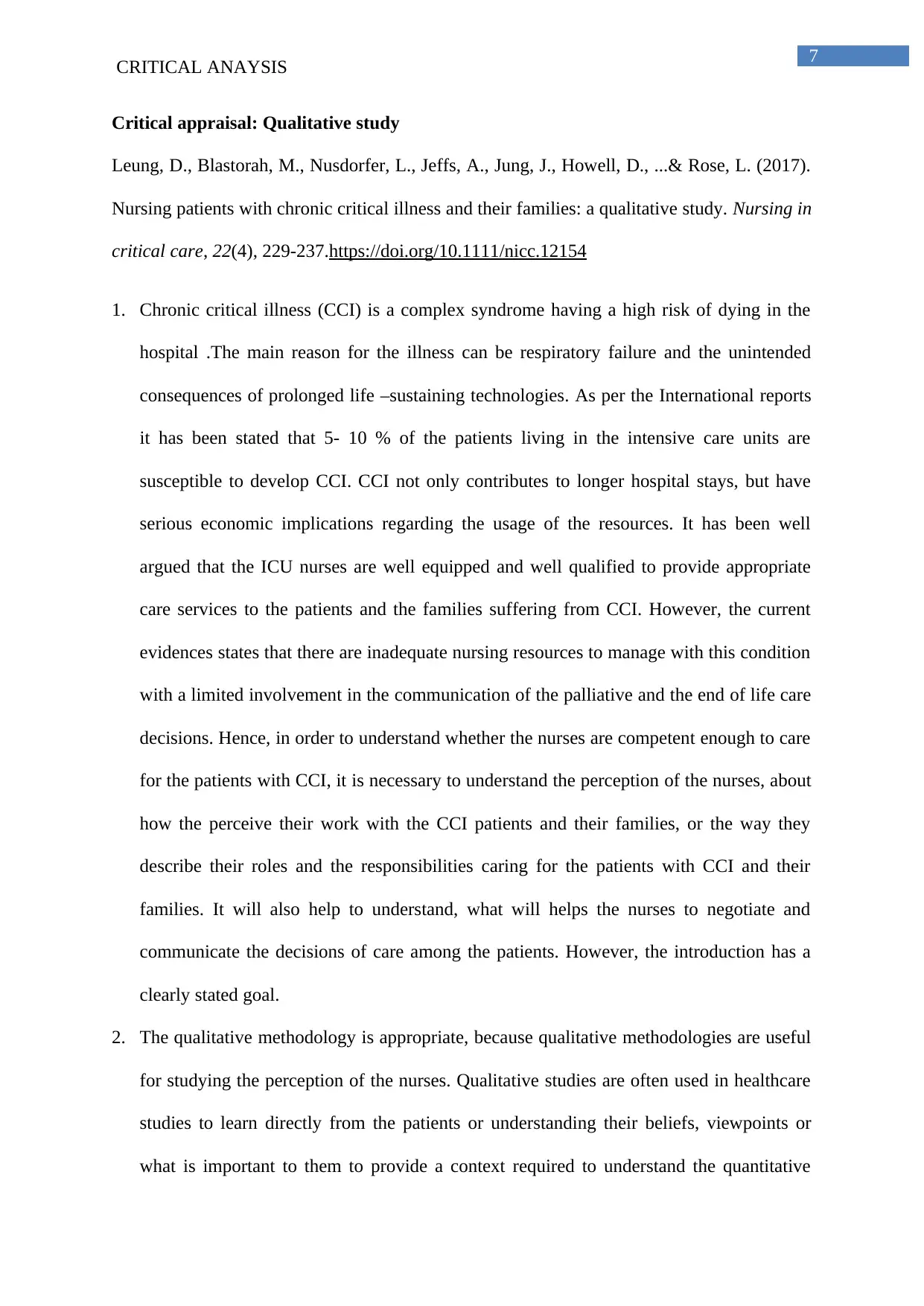
7
CRITICAL ANAYSIS
Critical appraisal: Qualitative study
Leung, D., Blastorah, M., Nusdorfer, L., Jeffs, A., Jung, J., Howell, D., ...& Rose, L. (2017).
Nursing patients with chronic critical illness and their families: a qualitative study. Nursing in
critical care, 22(4), 229-237.https://doi.org/10.1111/nicc.12154
1. Chronic critical illness (CCI) is a complex syndrome having a high risk of dying in the
hospital .The main reason for the illness can be respiratory failure and the unintended
consequences of prolonged life –sustaining technologies. As per the International reports
it has been stated that 5- 10 % of the patients living in the intensive care units are
susceptible to develop CCI. CCI not only contributes to longer hospital stays, but have
serious economic implications regarding the usage of the resources. It has been well
argued that the ICU nurses are well equipped and well qualified to provide appropriate
care services to the patients and the families suffering from CCI. However, the current
evidences states that there are inadequate nursing resources to manage with this condition
with a limited involvement in the communication of the palliative and the end of life care
decisions. Hence, in order to understand whether the nurses are competent enough to care
for the patients with CCI, it is necessary to understand the perception of the nurses, about
how the perceive their work with the CCI patients and their families, or the way they
describe their roles and the responsibilities caring for the patients with CCI and their
families. It will also help to understand, what will helps the nurses to negotiate and
communicate the decisions of care among the patients. However, the introduction has a
clearly stated goal.
2. The qualitative methodology is appropriate, because qualitative methodologies are useful
for studying the perception of the nurses. Qualitative studies are often used in healthcare
studies to learn directly from the patients or understanding their beliefs, viewpoints or
what is important to them to provide a context required to understand the quantitative
CRITICAL ANAYSIS
Critical appraisal: Qualitative study
Leung, D., Blastorah, M., Nusdorfer, L., Jeffs, A., Jung, J., Howell, D., ...& Rose, L. (2017).
Nursing patients with chronic critical illness and their families: a qualitative study. Nursing in
critical care, 22(4), 229-237.https://doi.org/10.1111/nicc.12154
1. Chronic critical illness (CCI) is a complex syndrome having a high risk of dying in the
hospital .The main reason for the illness can be respiratory failure and the unintended
consequences of prolonged life –sustaining technologies. As per the International reports
it has been stated that 5- 10 % of the patients living in the intensive care units are
susceptible to develop CCI. CCI not only contributes to longer hospital stays, but have
serious economic implications regarding the usage of the resources. It has been well
argued that the ICU nurses are well equipped and well qualified to provide appropriate
care services to the patients and the families suffering from CCI. However, the current
evidences states that there are inadequate nursing resources to manage with this condition
with a limited involvement in the communication of the palliative and the end of life care
decisions. Hence, in order to understand whether the nurses are competent enough to care
for the patients with CCI, it is necessary to understand the perception of the nurses, about
how the perceive their work with the CCI patients and their families, or the way they
describe their roles and the responsibilities caring for the patients with CCI and their
families. It will also help to understand, what will helps the nurses to negotiate and
communicate the decisions of care among the patients. However, the introduction has a
clearly stated goal.
2. The qualitative methodology is appropriate, because qualitative methodologies are useful
for studying the perception of the nurses. Qualitative studies are often used in healthcare
studies to learn directly from the patients or understanding their beliefs, viewpoints or
what is important to them to provide a context required to understand the quantitative

8
CRITICAL ANAYSIS
finding. It helps to have a deeper look than the analysis of the ranks and the counts by
recording the attitudes, behaviors and the feelings (Creswell, &Poth, 2017). Hence, in
order to evaluate whether there are appropriate care facilities for people suffering from
CCI or whether the nurses abide by their roles and responsibilities to care for the CCI
patients and their families.
3. In this paper, the researcher has provided a well-structured background as a rationale for
doing the qualitative research. This study used the methodology of Thorne’s interpretive
description (Thorne, 2016). The researcher has rightfully pointed out that the aim of using
this method is to inductively describe the phenomena from an interpretive viewpoint. It
has been clearly mentioned by the researcher that the method employs, social and cultural
forces impinge to the agency of the individuals and reveal a common subjective linkage,
patterns and therelationships(Thorne, 2016). Interpretive description is considered to be
an alternative to the conventional qualitative approaches that can provide a better
understanding of the complex practical phenomena.
4. Yes, The paper provided a detailed account of how the participants have been chosen
from one academic hospital in Toronto. They followed inclusion and exclusion criteria
while selecting the participants for the qualitative study. Only those patients who had
experience of more than equal to one year in a critical care unit and has provided care to
at least 2 critical care patients has been take in to consideration. The exclusion criteria
consisted of casual nursing student. The paper had clearly explained the rationale for
choosing this inclusion criteria, as CCI is referred to those dependent on mechanical
ventilation and critical care nurses caring for at least to two patients would probably have
some experiencesin dealing with criticalcare patients. However, the paper has not
provided with much information of why this target group has been chosen as the
participants.
CRITICAL ANAYSIS
finding. It helps to have a deeper look than the analysis of the ranks and the counts by
recording the attitudes, behaviors and the feelings (Creswell, &Poth, 2017). Hence, in
order to evaluate whether there are appropriate care facilities for people suffering from
CCI or whether the nurses abide by their roles and responsibilities to care for the CCI
patients and their families.
3. In this paper, the researcher has provided a well-structured background as a rationale for
doing the qualitative research. This study used the methodology of Thorne’s interpretive
description (Thorne, 2016). The researcher has rightfully pointed out that the aim of using
this method is to inductively describe the phenomena from an interpretive viewpoint. It
has been clearly mentioned by the researcher that the method employs, social and cultural
forces impinge to the agency of the individuals and reveal a common subjective linkage,
patterns and therelationships(Thorne, 2016). Interpretive description is considered to be
an alternative to the conventional qualitative approaches that can provide a better
understanding of the complex practical phenomena.
4. Yes, The paper provided a detailed account of how the participants have been chosen
from one academic hospital in Toronto. They followed inclusion and exclusion criteria
while selecting the participants for the qualitative study. Only those patients who had
experience of more than equal to one year in a critical care unit and has provided care to
at least 2 critical care patients has been take in to consideration. The exclusion criteria
consisted of casual nursing student. The paper had clearly explained the rationale for
choosing this inclusion criteria, as CCI is referred to those dependent on mechanical
ventilation and critical care nurses caring for at least to two patients would probably have
some experiencesin dealing with criticalcare patients. However, the paper has not
provided with much information of why this target group has been chosen as the
participants.
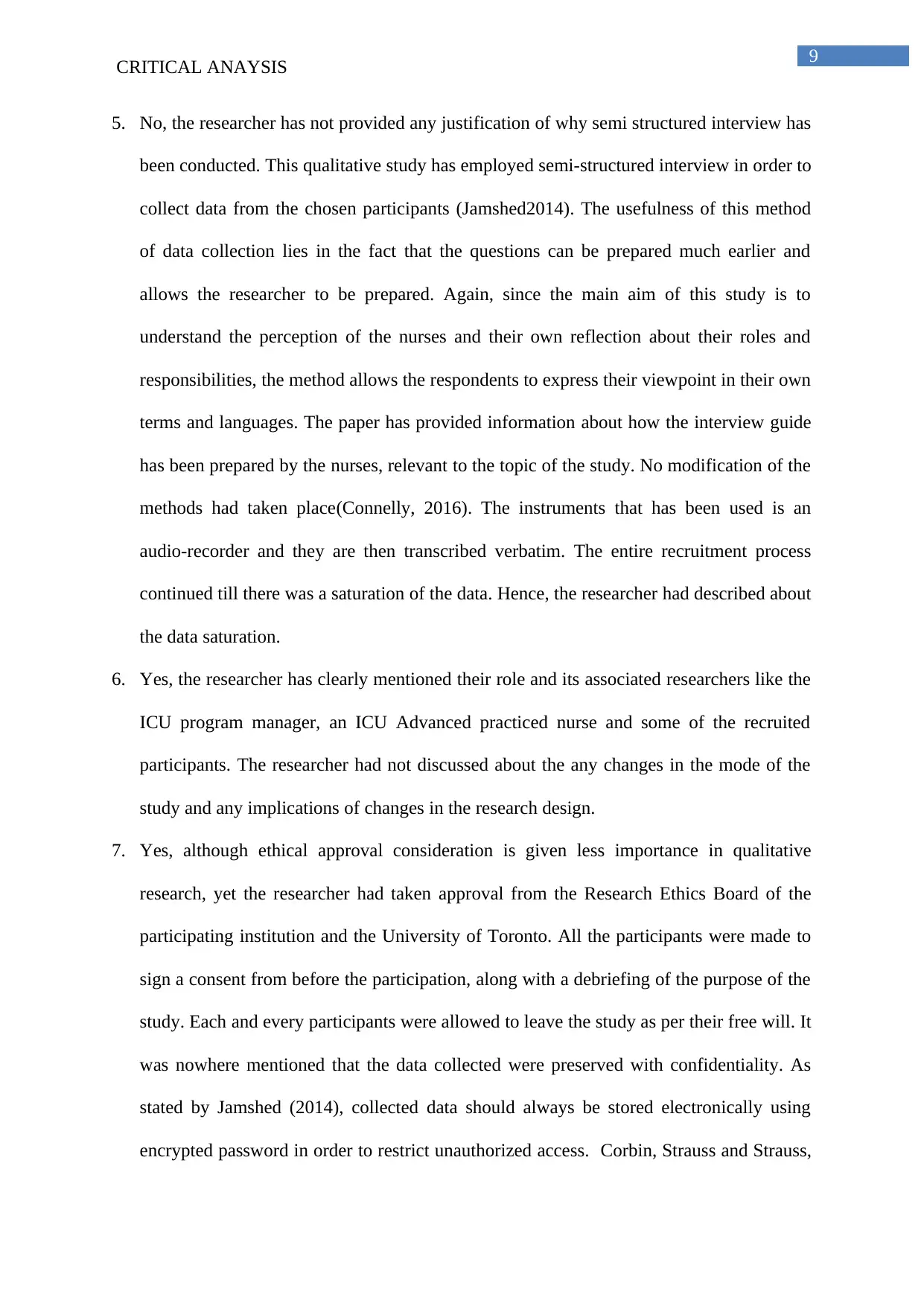
9
CRITICAL ANAYSIS
5. No, the researcher has not provided any justification of why semi structured interview has
been conducted. This qualitative study has employed semi-structured interview in order to
collect data from the chosen participants (Jamshed2014). The usefulness of this method
of data collection lies in the fact that the questions can be prepared much earlier and
allows the researcher to be prepared. Again, since the main aim of this study is to
understand the perception of the nurses and their own reflection about their roles and
responsibilities, the method allows the respondents to express their viewpoint in their own
terms and languages. The paper has provided information about how the interview guide
has been prepared by the nurses, relevant to the topic of the study. No modification of the
methods had taken place(Connelly, 2016). The instruments that has been used is an
audio-recorder and they are then transcribed verbatim. The entire recruitment process
continued till there was a saturation of the data. Hence, the researcher had described about
the data saturation.
6. Yes, the researcher has clearly mentioned their role and its associated researchers like the
ICU program manager, an ICU Advanced practiced nurse and some of the recruited
participants. The researcher had not discussed about the any changes in the mode of the
study and any implications of changes in the research design.
7. Yes, although ethical approval consideration is given less importance in qualitative
research, yet the researcher had taken approval from the Research Ethics Board of the
participating institution and the University of Toronto. All the participants were made to
sign a consent from before the participation, along with a debriefing of the purpose of the
study. Each and every participants were allowed to leave the study as per their free will. It
was nowhere mentioned that the data collected were preserved with confidentiality. As
stated by Jamshed (2014), collected data should always be stored electronically using
encrypted password in order to restrict unauthorized access. Corbin, Strauss and Strauss,
CRITICAL ANAYSIS
5. No, the researcher has not provided any justification of why semi structured interview has
been conducted. This qualitative study has employed semi-structured interview in order to
collect data from the chosen participants (Jamshed2014). The usefulness of this method
of data collection lies in the fact that the questions can be prepared much earlier and
allows the researcher to be prepared. Again, since the main aim of this study is to
understand the perception of the nurses and their own reflection about their roles and
responsibilities, the method allows the respondents to express their viewpoint in their own
terms and languages. The paper has provided information about how the interview guide
has been prepared by the nurses, relevant to the topic of the study. No modification of the
methods had taken place(Connelly, 2016). The instruments that has been used is an
audio-recorder and they are then transcribed verbatim. The entire recruitment process
continued till there was a saturation of the data. Hence, the researcher had described about
the data saturation.
6. Yes, the researcher has clearly mentioned their role and its associated researchers like the
ICU program manager, an ICU Advanced practiced nurse and some of the recruited
participants. The researcher had not discussed about the any changes in the mode of the
study and any implications of changes in the research design.
7. Yes, although ethical approval consideration is given less importance in qualitative
research, yet the researcher had taken approval from the Research Ethics Board of the
participating institution and the University of Toronto. All the participants were made to
sign a consent from before the participation, along with a debriefing of the purpose of the
study. Each and every participants were allowed to leave the study as per their free will. It
was nowhere mentioned that the data collected were preserved with confidentiality. As
stated by Jamshed (2014), collected data should always be stored electronically using
encrypted password in order to restrict unauthorized access. Corbin, Strauss and Strauss,
Secure Best Marks with AI Grader
Need help grading? Try our AI Grader for instant feedback on your assignments.
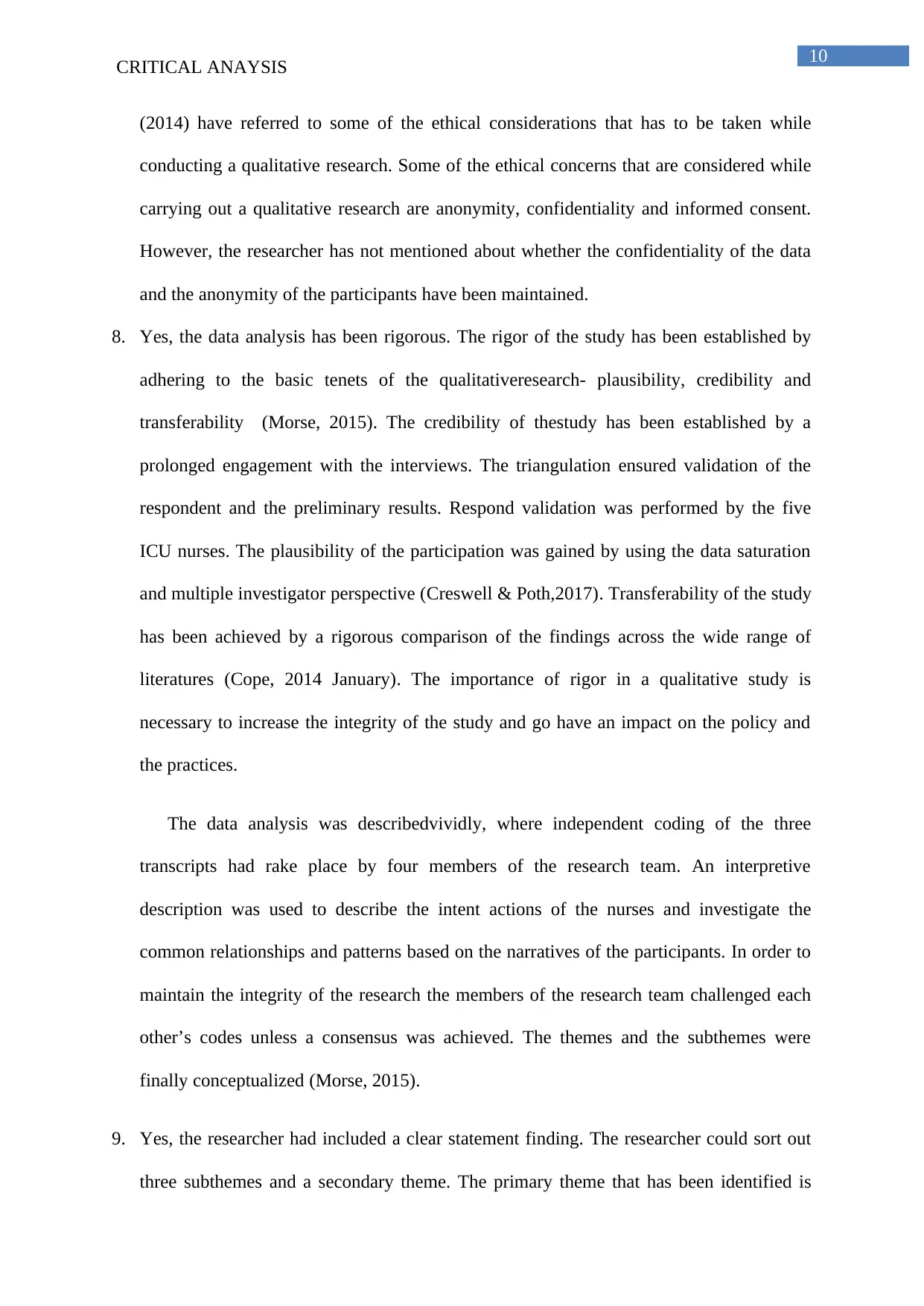
10
CRITICAL ANAYSIS
(2014) have referred to some of the ethical considerations that has to be taken while
conducting a qualitative research. Some of the ethical concerns that are considered while
carrying out a qualitative research are anonymity, confidentiality and informed consent.
However, the researcher has not mentioned about whether the confidentiality of the data
and the anonymity of the participants have been maintained.
8. Yes, the data analysis has been rigorous. The rigor of the study has been established by
adhering to the basic tenets of the qualitativeresearch- plausibility, credibility and
transferability (Morse, 2015). The credibility of thestudy has been established by a
prolonged engagement with the interviews. The triangulation ensured validation of the
respondent and the preliminary results. Respond validation was performed by the five
ICU nurses. The plausibility of the participation was gained by using the data saturation
and multiple investigator perspective (Creswell & Poth,2017). Transferability of the study
has been achieved by a rigorous comparison of the findings across the wide range of
literatures (Cope, 2014 January). The importance of rigor in a qualitative study is
necessary to increase the integrity of the study and go have an impact on the policy and
the practices.
The data analysis was describedvividly, where independent coding of the three
transcripts had rake place by four members of the research team. An interpretive
description was used to describe the intent actions of the nurses and investigate the
common relationships and patterns based on the narratives of the participants. In order to
maintain the integrity of the research the members of the research team challenged each
other’s codes unless a consensus was achieved. The themes and the subthemes were
finally conceptualized (Morse, 2015).
9. Yes, the researcher had included a clear statement finding. The researcher could sort out
three subthemes and a secondary theme. The primary theme that has been identified is
CRITICAL ANAYSIS
(2014) have referred to some of the ethical considerations that has to be taken while
conducting a qualitative research. Some of the ethical concerns that are considered while
carrying out a qualitative research are anonymity, confidentiality and informed consent.
However, the researcher has not mentioned about whether the confidentiality of the data
and the anonymity of the participants have been maintained.
8. Yes, the data analysis has been rigorous. The rigor of the study has been established by
adhering to the basic tenets of the qualitativeresearch- plausibility, credibility and
transferability (Morse, 2015). The credibility of thestudy has been established by a
prolonged engagement with the interviews. The triangulation ensured validation of the
respondent and the preliminary results. Respond validation was performed by the five
ICU nurses. The plausibility of the participation was gained by using the data saturation
and multiple investigator perspective (Creswell & Poth,2017). Transferability of the study
has been achieved by a rigorous comparison of the findings across the wide range of
literatures (Cope, 2014 January). The importance of rigor in a qualitative study is
necessary to increase the integrity of the study and go have an impact on the policy and
the practices.
The data analysis was describedvividly, where independent coding of the three
transcripts had rake place by four members of the research team. An interpretive
description was used to describe the intent actions of the nurses and investigate the
common relationships and patterns based on the narratives of the participants. In order to
maintain the integrity of the research the members of the research team challenged each
other’s codes unless a consensus was achieved. The themes and the subthemes were
finally conceptualized (Morse, 2015).
9. Yes, the researcher had included a clear statement finding. The researcher could sort out
three subthemes and a secondary theme. The primary theme that has been identified is
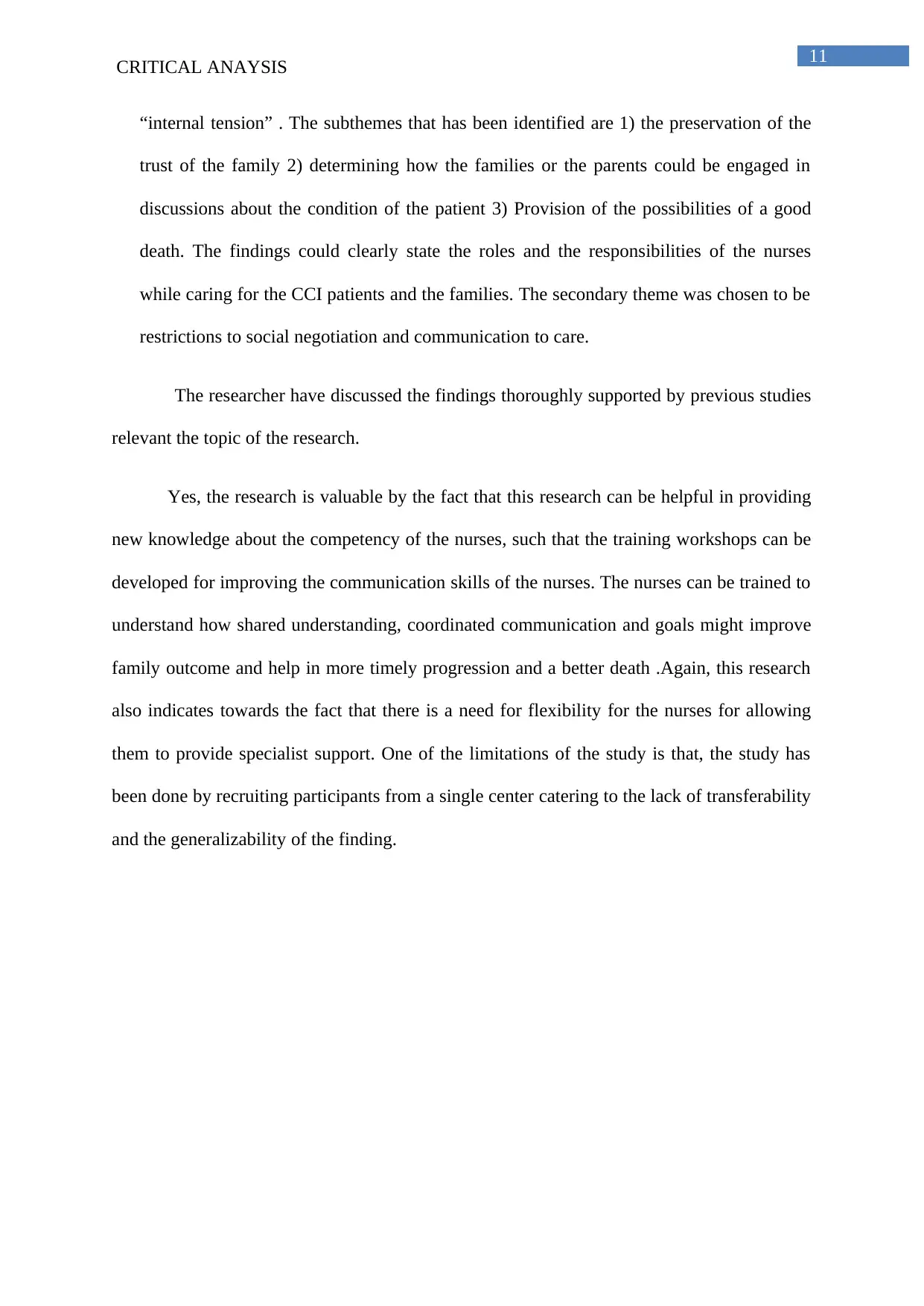
11
CRITICAL ANAYSIS
“internal tension” . The subthemes that has been identified are 1) the preservation of the
trust of the family 2) determining how the families or the parents could be engaged in
discussions about the condition of the patient 3) Provision of the possibilities of a good
death. The findings could clearly state the roles and the responsibilities of the nurses
while caring for the CCI patients and the families. The secondary theme was chosen to be
restrictions to social negotiation and communication to care.
The researcher have discussed the findings thoroughly supported by previous studies
relevant the topic of the research.
Yes, the research is valuable by the fact that this research can be helpful in providing
new knowledge about the competency of the nurses, such that the training workshops can be
developed for improving the communication skills of the nurses. The nurses can be trained to
understand how shared understanding, coordinated communication and goals might improve
family outcome and help in more timely progression and a better death .Again, this research
also indicates towards the fact that there is a need for flexibility for the nurses for allowing
them to provide specialist support. One of the limitations of the study is that, the study has
been done by recruiting participants from a single center catering to the lack of transferability
and the generalizability of the finding.
CRITICAL ANAYSIS
“internal tension” . The subthemes that has been identified are 1) the preservation of the
trust of the family 2) determining how the families or the parents could be engaged in
discussions about the condition of the patient 3) Provision of the possibilities of a good
death. The findings could clearly state the roles and the responsibilities of the nurses
while caring for the CCI patients and the families. The secondary theme was chosen to be
restrictions to social negotiation and communication to care.
The researcher have discussed the findings thoroughly supported by previous studies
relevant the topic of the research.
Yes, the research is valuable by the fact that this research can be helpful in providing
new knowledge about the competency of the nurses, such that the training workshops can be
developed for improving the communication skills of the nurses. The nurses can be trained to
understand how shared understanding, coordinated communication and goals might improve
family outcome and help in more timely progression and a better death .Again, this research
also indicates towards the fact that there is a need for flexibility for the nurses for allowing
them to provide specialist support. One of the limitations of the study is that, the study has
been done by recruiting participants from a single center catering to the lack of transferability
and the generalizability of the finding.

12
CRITICAL ANAYSIS
References
Bhide, A., Shah, P. S., & Acharya, G. (2018). A simplified guide to randomized controlled
trials. Acta obstetricia et gynecologica Scandinavica, 97(4), 380-387.
https://doi.org/10.1111/aogs.13309
Connelly, L. M. (2016). Trustworthiness in qualitative research. Medsurg Nursing, 25(6),
435-437.https://doi.org/10.1186/1471-2288-13-117
Cope, D. G. (2014, January). Methods and meanings: credibility and trustworthiness of
qualitative research. In Oncology nursing forum (Vol. 41, No. 1).ofile%3dehost
%26scope%3dsite%26authtype%3dcrawler%26jrnl%3d0190535X%26AN
%3d93340461
Corbin, J., Strauss, A., & Strauss, A. L. (2014). Basics of qualitative research. sage.
Cornejo-Juárez, P., Vilar-Compte, D., Pérez-Jiménez, C., Namendys-Silva, S. A., Sandoval-
Hernández, S., & Volkow-Fernández, P. (2015). The impact of hospital-acquired
infections with multidrug-resistant bacteria in an oncology intensive care
unit. International Journal of Infectious Diseases, 31, 31-34.
https://doi.org/10.1016/j.ijid.2014.12.022
Creswell, J. W., &Poth, C. N. (2017). Qualitative inquiry and research design: Choosing
among five approaches. Sage publications.
Geisinger, E., & Isberg, R. R. (2017). Interplay between antibiotic resistance and virulence
during disease promoted by multidrug-resistant bacteria. The Journal of infectious
diseases, 215(suppl_1), S9-S17. https://doi.org/10.1093/infdis/jiw402
CRITICAL ANAYSIS
References
Bhide, A., Shah, P. S., & Acharya, G. (2018). A simplified guide to randomized controlled
trials. Acta obstetricia et gynecologica Scandinavica, 97(4), 380-387.
https://doi.org/10.1111/aogs.13309
Connelly, L. M. (2016). Trustworthiness in qualitative research. Medsurg Nursing, 25(6),
435-437.https://doi.org/10.1186/1471-2288-13-117
Cope, D. G. (2014, January). Methods and meanings: credibility and trustworthiness of
qualitative research. In Oncology nursing forum (Vol. 41, No. 1).ofile%3dehost
%26scope%3dsite%26authtype%3dcrawler%26jrnl%3d0190535X%26AN
%3d93340461
Corbin, J., Strauss, A., & Strauss, A. L. (2014). Basics of qualitative research. sage.
Cornejo-Juárez, P., Vilar-Compte, D., Pérez-Jiménez, C., Namendys-Silva, S. A., Sandoval-
Hernández, S., & Volkow-Fernández, P. (2015). The impact of hospital-acquired
infections with multidrug-resistant bacteria in an oncology intensive care
unit. International Journal of Infectious Diseases, 31, 31-34.
https://doi.org/10.1016/j.ijid.2014.12.022
Creswell, J. W., &Poth, C. N. (2017). Qualitative inquiry and research design: Choosing
among five approaches. Sage publications.
Geisinger, E., & Isberg, R. R. (2017). Interplay between antibiotic resistance and virulence
during disease promoted by multidrug-resistant bacteria. The Journal of infectious
diseases, 215(suppl_1), S9-S17. https://doi.org/10.1093/infdis/jiw402
Paraphrase This Document
Need a fresh take? Get an instant paraphrase of this document with our AI Paraphraser
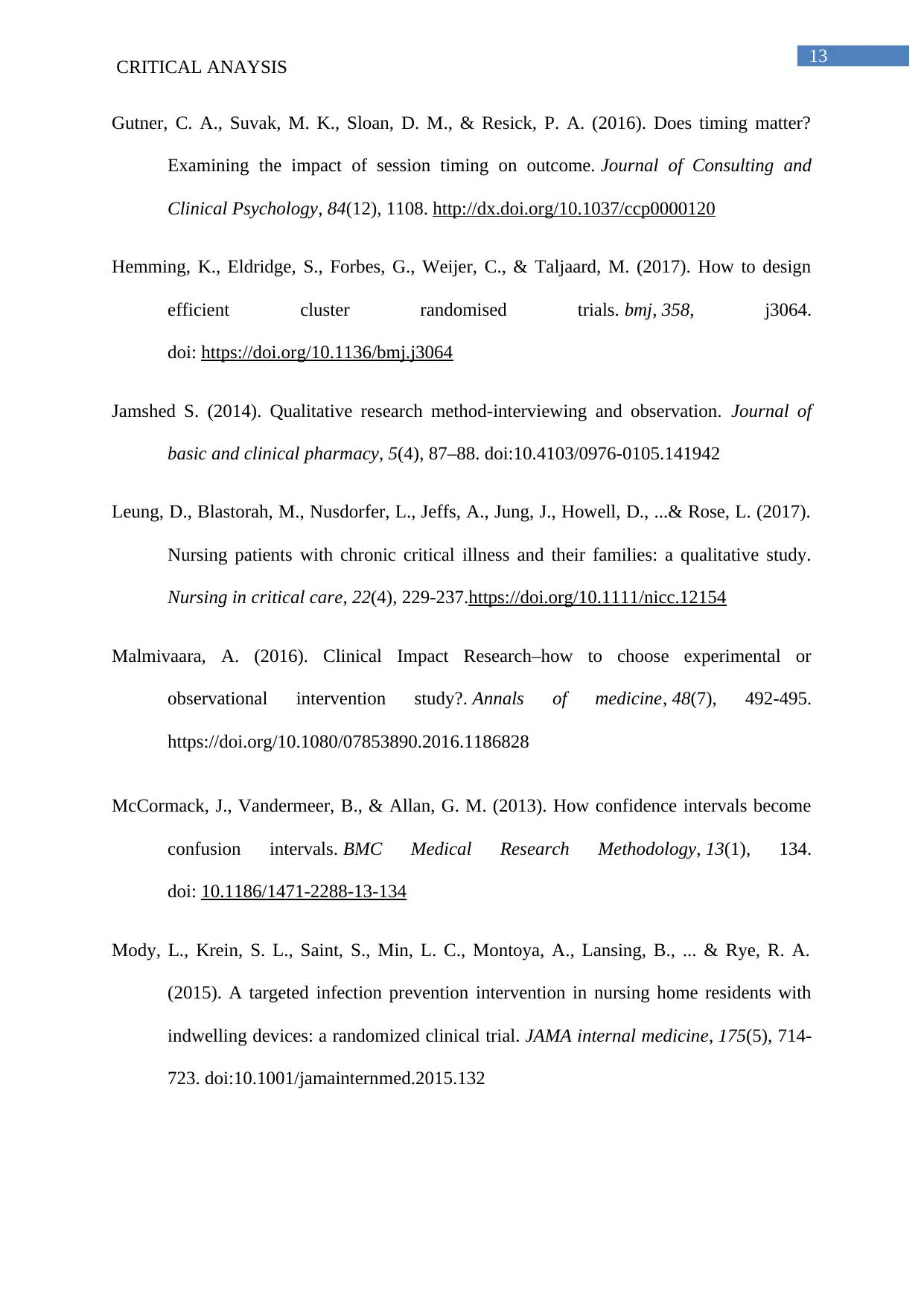
13
CRITICAL ANAYSIS
Gutner, C. A., Suvak, M. K., Sloan, D. M., & Resick, P. A. (2016). Does timing matter?
Examining the impact of session timing on outcome. Journal of Consulting and
Clinical Psychology, 84(12), 1108. http://dx.doi.org/10.1037/ccp0000120
Hemming, K., Eldridge, S., Forbes, G., Weijer, C., & Taljaard, M. (2017). How to design
efficient cluster randomised trials. bmj, 358, j3064.
doi: https://doi.org/10.1136/bmj.j3064
Jamshed S. (2014). Qualitative research method-interviewing and observation. Journal of
basic and clinical pharmacy, 5(4), 87–88. doi:10.4103/0976-0105.141942
Leung, D., Blastorah, M., Nusdorfer, L., Jeffs, A., Jung, J., Howell, D., ...& Rose, L. (2017).
Nursing patients with chronic critical illness and their families: a qualitative study.
Nursing in critical care, 22(4), 229-237.https://doi.org/10.1111/nicc.12154
Malmivaara, A. (2016). Clinical Impact Research–how to choose experimental or
observational intervention study?. Annals of medicine, 48(7), 492-495.
https://doi.org/10.1080/07853890.2016.1186828
McCormack, J., Vandermeer, B., & Allan, G. M. (2013). How confidence intervals become
confusion intervals. BMC Medical Research Methodology, 13(1), 134.
doi: 10.1186/1471-2288-13-134
Mody, L., Krein, S. L., Saint, S., Min, L. C., Montoya, A., Lansing, B., ... & Rye, R. A.
(2015). A targeted infection prevention intervention in nursing home residents with
indwelling devices: a randomized clinical trial. JAMA internal medicine, 175(5), 714-
723. doi:10.1001/jamainternmed.2015.132
CRITICAL ANAYSIS
Gutner, C. A., Suvak, M. K., Sloan, D. M., & Resick, P. A. (2016). Does timing matter?
Examining the impact of session timing on outcome. Journal of Consulting and
Clinical Psychology, 84(12), 1108. http://dx.doi.org/10.1037/ccp0000120
Hemming, K., Eldridge, S., Forbes, G., Weijer, C., & Taljaard, M. (2017). How to design
efficient cluster randomised trials. bmj, 358, j3064.
doi: https://doi.org/10.1136/bmj.j3064
Jamshed S. (2014). Qualitative research method-interviewing and observation. Journal of
basic and clinical pharmacy, 5(4), 87–88. doi:10.4103/0976-0105.141942
Leung, D., Blastorah, M., Nusdorfer, L., Jeffs, A., Jung, J., Howell, D., ...& Rose, L. (2017).
Nursing patients with chronic critical illness and their families: a qualitative study.
Nursing in critical care, 22(4), 229-237.https://doi.org/10.1111/nicc.12154
Malmivaara, A. (2016). Clinical Impact Research–how to choose experimental or
observational intervention study?. Annals of medicine, 48(7), 492-495.
https://doi.org/10.1080/07853890.2016.1186828
McCormack, J., Vandermeer, B., & Allan, G. M. (2013). How confidence intervals become
confusion intervals. BMC Medical Research Methodology, 13(1), 134.
doi: 10.1186/1471-2288-13-134
Mody, L., Krein, S. L., Saint, S., Min, L. C., Montoya, A., Lansing, B., ... & Rye, R. A.
(2015). A targeted infection prevention intervention in nursing home residents with
indwelling devices: a randomized clinical trial. JAMA internal medicine, 175(5), 714-
723. doi:10.1001/jamainternmed.2015.132

14
CRITICAL ANAYSIS
Morse, J. M. (2015). Critical analysis of strategies for determining rigor in qualitative
inquiry. Qualitative health research, 25(9), 1212-
1222.https://doi.org/10.1177/1094428112452151
Raja, S. A., Ashraf, M., Raja, S. A., Anjum, A. A., & Mubarak, N. (2019). Prevalence of
multi-drug resistant Staphylococcus aureus among healthcare staff members in
Surgical Intensive care unit of a large tertiary care hospital in Lahore. International
Journal Of Advanced Biotechnology And Research, 10(1), 99-108. Retrieved from:
https://www.researchgate.net/profile/Sa_Raja/publication/330524753_Prevalence_of_
multi-
drug_resistant_staphylococcus_aureus_among_healthcare_staff_members_in_surgical
_intensive_care_unit_of_a_large_tertiary_care_hospital_in_lahore/links/
5c46498aa6fdccd6b5bf1348/Prevalence-of-multi-drug-resistant-staphylococcus-
aureus-among-healthcare-staff-members-in-surgical-intensive-care-unit-of-a-large-
tertiary-care-hospital-in-lahore.pdf
Thorne, S. (2016). Interpretive description.
Routledge.https://doi.org/10.4324/9781315426259
Thorne, S. E. (2014). Applied interpretive approaches. The Oxford handbook of qualitative
research, 99, 115.
Wartolowska, K., Beard, D., & Carr, A. (2017). Blinding in trials of interventional
procedures is possible and worthwhile. F1000Research, 6.
doi: 10.12688/f1000research.12528.2
CRITICAL ANAYSIS
Morse, J. M. (2015). Critical analysis of strategies for determining rigor in qualitative
inquiry. Qualitative health research, 25(9), 1212-
1222.https://doi.org/10.1177/1094428112452151
Raja, S. A., Ashraf, M., Raja, S. A., Anjum, A. A., & Mubarak, N. (2019). Prevalence of
multi-drug resistant Staphylococcus aureus among healthcare staff members in
Surgical Intensive care unit of a large tertiary care hospital in Lahore. International
Journal Of Advanced Biotechnology And Research, 10(1), 99-108. Retrieved from:
https://www.researchgate.net/profile/Sa_Raja/publication/330524753_Prevalence_of_
multi-
drug_resistant_staphylococcus_aureus_among_healthcare_staff_members_in_surgical
_intensive_care_unit_of_a_large_tertiary_care_hospital_in_lahore/links/
5c46498aa6fdccd6b5bf1348/Prevalence-of-multi-drug-resistant-staphylococcus-
aureus-among-healthcare-staff-members-in-surgical-intensive-care-unit-of-a-large-
tertiary-care-hospital-in-lahore.pdf
Thorne, S. (2016). Interpretive description.
Routledge.https://doi.org/10.4324/9781315426259
Thorne, S. E. (2014). Applied interpretive approaches. The Oxford handbook of qualitative
research, 99, 115.
Wartolowska, K., Beard, D., & Carr, A. (2017). Blinding in trials of interventional
procedures is possible and worthwhile. F1000Research, 6.
doi: 10.12688/f1000research.12528.2
1 out of 15
Related Documents
Your All-in-One AI-Powered Toolkit for Academic Success.
+13062052269
info@desklib.com
Available 24*7 on WhatsApp / Email
![[object Object]](/_next/static/media/star-bottom.7253800d.svg)
Unlock your academic potential
© 2024 | Zucol Services PVT LTD | All rights reserved.




